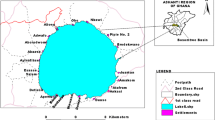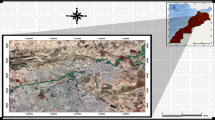Abstract
The Linggi river drainage basin in Negeri Sembilan, Malaysia supplies water to the whole of Port Dickson district and meets 50% of the Seremban district needs. The Linggi River, the main tributary, passes through the highly urbanised and densely populated Seremban district while the water treatment plant is located 16 km downstream. In 1979 the USEPA declared the river unsuitable as a source of raw water whereas the WHO classified it as being heavily polluted requiring more extensive and effective treatment. In order to meet the WHO drinking water standards, an ozonation system was installed in the conventional water treatment plant. The objective of ozonation is for the control and removal of organic micropollutants and other deleterious matters. This study investigated the concentrations and distribution of organic micropollutants, heavy metals, and bacteriological counts in water samples collected from within the catchment and the treated water. The effectiveness of the ozonation system was also studied. The total level of phenolic water pollutants in the catchment was generally found to be very much higher than the maximum recommended level of 2.0 µgl-1. The extensive treatment process carried out at the plant was very effective in reducing the levels of total phenols in the treated water to less than 1.0 µgl-1. However the process was not efficient enough to reduce the levels of some heavy metals as required by the standards, for examples Cd and Pb were still three times higher than the standards of 5µgl-1 and 0.05 mgl-1 respectively. For bacteriological study, coliform group of bacteria, Salmonella, faecal streptococci and injured coliform were monitored in the raw and treated water. The raw water contained coliforms about 1000 times higher than the required standard for raw ater, but after the secondary treatment by ozonation coliform bacteria were absent, however a small number of Salmonella was still present occasionally. The study also showed that restructuring of the district and relocating of some commercial activities along the river banks to other areas carried out over the last five years has improved the general quality of the river water.
Similar content being viewed by others
References
Abdullah, M. P. and Nainggolan, H.: 1991, ‘Phenolic water pollutants in a Malaysian river basin’, Environ. Monit. Assess. 19, 423–431.
Anon.: 1989, Structural Plan of Seremban, Seremban Municipal Council, Negeri Sembilan, pp. 257.
APHA: 1985, Standard Methods for the Examination of Water and Wastewater, 16th edition, American Public Health Association, Washington, D. C.
Binnic & Co.: 1979, Report on Development Plan for Seremban and Port Dickson Water Supply. Negeri Sembilan State Government: 110–120.
Condic, L. W.: 1986, ‘Toxicological problems associated with chlorine dioxide’, J. Am. Water Works Assoc. 78, 73–78.
Dauphinais, R. M. and Robben, G. G.: 1968, ‘Fatal infection due to Chromobacterium violaceum’, Am. J. Clin. Pathol. 50, 592–597.
Geiger, W. and Schaffuer, C.: 1981, ‘Determination of phenolic water pollutants by glass capillary gas chromatography’ in Keith, L. H. (ed.), The Identification and Analysis of Organic Pollutants in water Vol. 1, Ann Arbor Science Publishers, Michigan, Chapter 8, pp. 141–154.
Hassan, H., Suntharalingam, S. and Dhillon, K.S.: 1993, ‘Fatal Chromobacterium violaceum septicemia’, Sing. Medical J. 34, 456–458.
Hunt, G. T., Clement, W. H. and Faust, S. D.: 1977, ‘An evaluation of technique for the recovery and identification of trace quantities of phenolic compounds in natural waters’ In Ewing, G. W. (ed.), Environmental Analysis, Academic Press, pp. 57–78.
Johari, M. A.: 1989, ‘The upgrading of the Sg. Linggi treatment system of the removal of organic micropollutants’, Specialised Conference on Organic Micropollutants, Barcelona, Spain, Sept. 1989.
Johari, M. A.: 1993, ‘Water Supply Treatment System: An Overview’, in Jangi, M. S. (ed.), Drinking Water Quality: Microbiological and Public Health Aspects, Universiti Kebangsaan Malaysia, Bangi, pp.11–22.
Keith, L. H. and Telliard, W,A.: 1979, ‘Priority pollutants I: A perspective view’, Environ. Sci. Technol. 13, 416–423.
Malaysia: 1987, National Guidelines for Drinking Water Quality, Ministry of Health, Kuala Lumpur.
McFeters, G. A, Kippin, J. S. and LeChevallier, M. W.: 1986, ‘Injured coliform in drinking water’, Appl. Environ. Microbiol. 51, 1–5.
Sarmani, S., Abdullah, M. P., Baba, I. and Majid, A. A.: 1992, ‘Inventory of heavy metals and organic micropollutants in an urban water catchment drainage basin’, Hydrobiol. 235/236, 669–674.
Shinriki, N., Ishizaki, S., Sato, S., Sawadaishi, U. and Ueda, T.: 1984, ‘Degradation of nucleic acids with ozone, IV. Labilation of the double-helical structure of cell thymus deoxyribonucleic acid’, Chem. Pharm. Bull. 32, 3626–3640
Suess, M. I. 1982, Examination of Water for Pollution Control, Vol. 2, Pergamon Press, Oxford, Chapter 4, pp.451–470.
Ti, T.Y., Tan, W.C. and Chong, A.P.Y.: 1993, ‘Nonfatal and fatal infections caused by Chromobacterium violaceum’, Clinic. Infectious Dis. 17, 505–507.
Victorin, K.: 1992, ‘Review of the fenotoxicity of ozone’, Mut. Res. 277, 221–238.
WHO: 1985, Guidelines for Drinking Water Quality, Vol. 3, World Health Organization, Geneva.
Author information
Authors and Affiliations
Rights and permissions
About this article
Cite this article
Hamzah, A., Abdullah, M.P., Sarmani, S. et al. Chemical and Bacteriological Monitoring of Drinking Water from an Urbanised Water Catchment Drainage Basin. Environ Monit Assess 44, 327–338 (1997). https://doi.org/10.1023/A:1005795615266
Issue Date:
DOI: https://doi.org/10.1023/A:1005795615266




